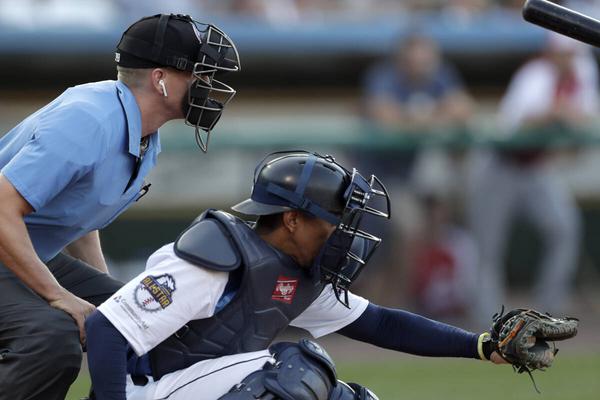Baseball's automated ball and strike system – so-called robo umps – debuted Tuesday in the Triple A Pacific Coast League, the highest level yet to experiment with the technology.
Major League Baseball had earlier introduced the ABS to the independent Atlantic League and it was in effect during the Arizona Fall League last year. And the White Sox's Triple-A Knights, in the International League, have deployed the system in Charlotte already this season. Tuesday's introduction in the PCL was the fullest planned roll out of the ABS in Triple A ballparks this season.
The ABS was in place Tuesday night at Smith's Park in Salt Lake for a game between the Bees (Angels affiliate) and the Albuquerque Isotopes (Rockies) and its debut was mostly uneventful.
"The home plate umpire, Brennan Miller, seemed to inform everyone of calls as quickly as he would if was making the decision," Isotopes broadcaster Josh Suchon tweeted. "I was never awkwardly waiting to get the call and relay that on the broadcast."
Kris Bryant, on a Rockies rehab assignment, hit second for Albuquerque on Tuesday and went 1-for-3. After the game he told Suchon that he was mostly curious about the new system.
"I'm not totally against it," Bryant said. "Umpires want to get the calls right. They're not out there trying to influence the game one way or the other. If they have a tool at their advantage to every call right, that's great."
While things seemed to go smoothly on Tuesday in the PCL, some in the majors are concerned about the technology and what recourse players and managers will have if it isn't ready for primetime.
"I'm glad they're trying it there as opposed to implementing it here because the one we've seen when we used it in spring training 2.0 when we didn't have umpires, we were playing intrasquad games, it's not ready," said Cleveland Guardians manager Terry Francona.

"The technology that we had, the strike zone's not good," Francona added. "You could throw a curveball and it can bounce and it's a strike. There would be a lot of ejections. I think east and west are really good, but up and down it's got some work to do. Because all it has to do is touch a part of the plate."
Who would Francona go after if the system isn't accurate?
"A computer," he said. "And I'd kick its ass, too. You imagine charging the plate with a computer in your hand?"
MLB provided a reference sheet to teams explaining how the ABS works. The strike zone extends 19 inches wide at the middle point of home plate, including an inch off either edge (home plate is 17 inches wide). The top and bottom edges of the strike zone are based on specific percentages of the batter's height. The size of the automated zone, MLB said, is similar to the major-league zone.
Importantly, though, if any part of the ball even nicks the zone, the pitch is called a strike.
"I wish there was more of, you have to have X percentage of the ball that crosses the zone for it to be a strike," Bryant said. "Because the ones that just nick the corner, that's the gray area. As a pitcher you're like, 'maybe it's a strike?' And as a hitter you're like, 'I don't know either.'"
Brennan Miller, the home plate umpire Tuesday night in Salt Lake, had experience with the ABS working in the Fall League. He received the ball-strike call through an earpiece and then signaled it as he normally would.
"No pitches outrageously out of the strike zone were called a strike and no pitches down the middle were called a ball," said Suchon "No pitches bounced into the strike zone that were called a strike. It was honestly uneventful in that regard."
Teams were provided computer tablets in their dugouts to review what the system was seeing. And some calls, as before, were disputed, including a called strike in the ninth inning that brushed the outside of the zone, according to Suchon.
"As a hitter, it's going to be weird," Bryant said before the game. "Sometimes you get a call to go your way when a guy sets up inside and they throw it outside and but it just looks terrible."
(Photo: Daniela Porcelli / Getty Images)




